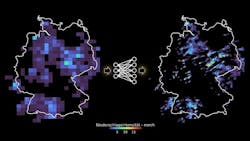Researchers of Karlsruhe Institute of Technology (KIT) have developed a global climate model method based on artificial intelligence (AI) that produces more precise modelling, according to a KIT press release.
The release states that the new methos can increase the precision of coarse precipitation fields generated by global climate models. The researchers succeeded in improving spatial resolution of precipitation fields from 32 to two kilometers and temporal resolution from one hour to ten minutes. This higher resolution is required to better forecast the more frequent occurrence of heavy local precipitation and the resulting natural disasters in future.
Researchers expect that increasing average temperatures will cause extreme precipitation events to further increase. To adapt to a changing climate and prepare for disasters at an early stage, precise local and global data on the current and future water cycle are indispensable.
“Precipitation is highly variable in space and time and, hence, difficult to forecast, in particular on the local level,” said Christian Chwala from the Atmospheric Environmental Research Division of KIT’s Institute of Meteorology and Climate Research. “For this reason, we want to enhance the resolution of precipitation fields generated e.g. by global climate models and improve their classification as regards possible threats, such as floodings.”
Currently used global climate models are based on a grid that is not fine enough to precisely present the variability of precipitation. Highly resolved precipitation maps can only be produced with computationally expensive and, hence, spatially or temporally limited models.
“For this reason, we have developed an AI-based generative neural network, called GAN, and trained it with high-resolution radar precipitation fields. In this way, the GAN learns how to generate realistic precipitation fields and derive their temporal sequence from coarsely resolved data,” said Luca Glawion, co-author. “The network is able to generate highly resolved radar precipitation films from very coarsely resolved maps.”
These refined radar maps not only show how rain cells develop and move, but precisely reconstruct local rain statistics and the corresponding extreme value distribution.
“Our method serves as a basis to increase the resolution of coarsely grained precipitation fields, such that the high spatial and temporal variability of precipitation can be reproduced adequately and local effects can be studied,” said Julius Polz, co-author. “Our deep learning method is quicker by several orders of magnitude than the calculation of such highly resolved precipitation fields with numerical weather models usually applied to regionally refine data of global climate models.”
The researchers point out that their method also generates an ensemble of different potential precipitation fields. Similar to a weather forecast, an ensemble allows for a more precise determination of the associated uncertainty.
The results show that the AI model and methodology developed by the researchers will enable future use of neural networks to improve the spatial and temporal resolution of precipitation calculated by climate models. This will allow for a more precise analysis of the impacts and developments of precipitation in a changing climate.






